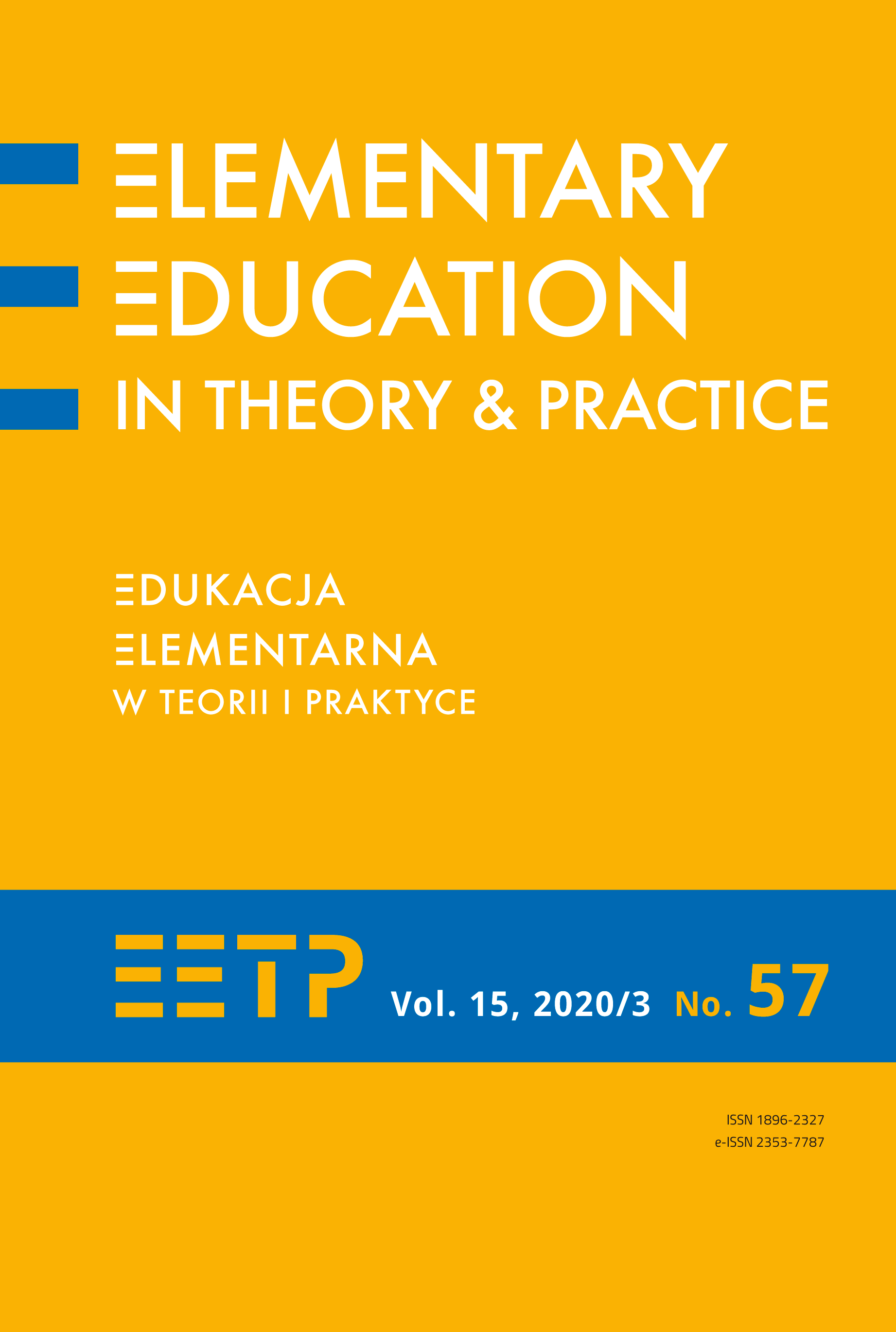Work with the child’s body in Izabela Chlewińska’s performative installation “Body”
Abstract
The ideas presented in this article elaborate on an issue of the body, which plays the role of a tool that enables inclusion. Izabela Chlewinska’s performative installation Body constitutes an example of art, whose role is to emphasize the importance of improving body awareness. In the article, methods of working with the body are described, the aim of which is to introduce a child to the world of sensory sensations—the world which is close and necessary for a child. The world of sensory sensations and movement is the basis for proper personal development. The article discusses working with children with autism spectrum disorders. Through free expression and actions aimed at boosting creativity, children who participate in the performative installation remain in a pleasant flow state, during which their actions are consistent with their individual internal needs.
References
American Psychiatric Association. (2013). Diagnostic and statistical manual of mental disorders: DSM-5. Washington.
Barrett, L.F. (2017). How emotions are made: The secret life of the brain. Houghton Mifflin Harcourt.
Bogdanowicz M., Kisiel B., Przasnyska M. (1992). Metoda Weroniki Sherborne w terapii i wspomaganiu rozwoju dziecka [Weronika Sherborne’s method in therapy and support of child development], Warsaw: School and Pedagogical Publisher.
Csikszentmihalyi M. (1996). Psychologia optymalnego doświadczenia [The psychology of optimal experience], trans. M. Wajda, Warsaw: Studio Emka.
Damasio, A.R. (2000). Descartes’ error: Emotion, reason, and the human brain. New York: Quill.
Danielewicz D., Pisula E. (2003). Terapia i edukacja osób z autyzmem [Therapy and education of people with autism], Warsaw: Maria Grzegorzewska Academy of Special Education.
Fröhlich A. (1998). Stymulacja od podstaw [Basic stimulation], trans. Z. Białek, L. Czarkowska, A. Firkowska-Mankiewicz. Warsaw: WSiP.
Gallese V., Goldman A. (1998). Mirror neurons and the simulation theory of mind-reading, “Trends in Cognitive Science,” 2 (12), pp. 493–501.
Kepner J. (1991). Ciało w procesie psychoterapii Gestalt, [Body process: A Gestalt approach to working with the body in psychotherapy], trans. E. Knoll, Warsaw: Pusty Obłok.
Krasoń K. (2005). Wymiary ekspresji dziecięcej [Dimensions of child expression], [in:] Jakubiec S., Problemy społeczne dzieci twórczych [Social problems of creative children], Katowice: Children’s Expression Center at the Śląska Library.
Merleau-Ponty M. (2001). Fenomenologia percepcji [Phenomenology of perception], trans. M. Kowalska, J. Migasiński, Warsaw: Aletheia Foundation.
Panconesci E., Hautmann G. (1996). Psychophysiology of stress in dermatology. The psychobiologic pattern of psychosomatics, “Psychodermatology” 14, pp. 399-421.
Schier K. (2009). Piękne brzydactwo [A beautiful ugly thing], Warsaw: Scholar Scientific.
Serwińska J. (2018). “Senso Paka” budowanie relacji przez stymulację polisensoryczną [“Senso Paka”: building relationships through polysensory stimulation]. https://tera-piaspecjalna.pl/artykul/senso-paka-budowanie-relacji-przez-stymulacje-polisensoryczna (accessed: 10.06.2020).
Shusterman R. (2010). Świadomość ciała [Body Consciousness], trans. W. Małecki, S. Stankiewicz, Krakow: TAiWPN UNIWERSITAS.
Shusterman R. (2012). Body and the arts: The need for somaesthetics, “Diogenes,” 59(1–2) 7–20.
Sipowicz K., Pietras T. (2017). Wprowadzenie do pedagogiki inkluzyjnej (włączającej) [Introduction to inclusive pedagogy], Wrocław: Continuo.
Szeler K. (2007). Wybrane metody terapii osób dotkniętych autyzmem w świetle literatury [Selected methods of therapy for autistic people in literature], “Paedagogia Christiana,” vol. 20 no. 2, pp. 113–127.
[wk]. warszawska-kulturalna (2020). Co dwie sztuki to nie jedna – wystawa w Zachęcie [Two arts are better than one – the exhibition in Zachęta], http://warszawska-kultural- na.pl/dwie-sztuki-jedna-wystawa-zachecie (accessed: 03.05.2020)
Ad Verheul and Jan Hulsegge (http://www.isna-mse.org/assets/konferencja-snoezelen.pdf (accessed: 10.06.2020)
Intibag https://intibag.eu/pl/obiekty-sensoryczne (accessed: 01.05.2020)
Radio broadcast Sunday morning on Radio Dla Ciebie (February 16, 2020) https://www.rdc.pl/podcast/niedzielny-poranek-instalacja-cialo-na-wystawie-co-dwie-sztuki-to--nie-jedna (accessed: 01.05.2020)
Performative installation: The Body Authors of the exhibition: Iza Chlewińska, Tomasz Bergmann, and Miłosz
Sensory objects, Set design: Tomasz Bergmann. Performers: Izabela Chlewińska, Aneta Jankowska, Aleksandra Muszyńska-Bożek, Katarzyna Sitarz, Marta Bury, Krystian Łysoń. Music: Marcin Lenarczyk
Copyright (c) 2020 Elementary Education in Theory and Practice

This work is licensed under a Creative Commons Attribution-NoDerivatives 4.0 International License.
- When submitting a text, the author declares that he/she is the Author of the article (hereinafter referred to as the “Work”) and:
- he/she owns the exclusive and unlimited copyright to the Work,
- is entitled to dispose of the copyright to the Work.
Declares that it does not infringe any third party copyrights or legal rights.
Declares that there is no conflict of interest.
2. At the same time, the Author grants the Ignatianum University in Cracowa royalty-free, non-exclusive and territorially unlimited licence to use the Work in the following fields of exploitation:
- recording the Work in a hard copy, as well as on a digital or magnetic medium;
- reproduction of the Work using any technique, without limitation of the number of editions or copies;
- distribution of the Work and its copies on any medium, including marketing, sale, lending, and rental;
- introduction of the Work into a computer memory;
- disseminating the Work in information networks, including in the Internet;
- public performance, exhibition, display, reproduction, broadcasting and re-broadcasting, as well as making the Work available to the public in such a way that everyone can have access to it at a time and place of their own choosing;
- within the scope of dependent rights to the Work, including in particular the right to make necessary changes to the Work resulting from editorial and methodical development, as well as to translate the Work into foreign languages;
The licence is granted from the moment of the transfer of the Work to the Ignatianum University in Cracow. The Ignatianum University in Cracow is entitled to grant further sub-licences to the Work within the scope of the right granted. The licence is time-limited and it is granted for a period of 15 years, starting from the date of its granting.
Authors are permitted and encouraged to publish their text online (e.g. in their institution’s repository or on the institution’s website) before or during the submission process as this may lead to beneficial exchanges, as well as earlier and greater citation of the published text (See The Effect of Open Access). We recommend using any of the following portals of research associations:
- ResearchGate
- SSRN
- Academia.edu
- Selected Works
- Academic Search




